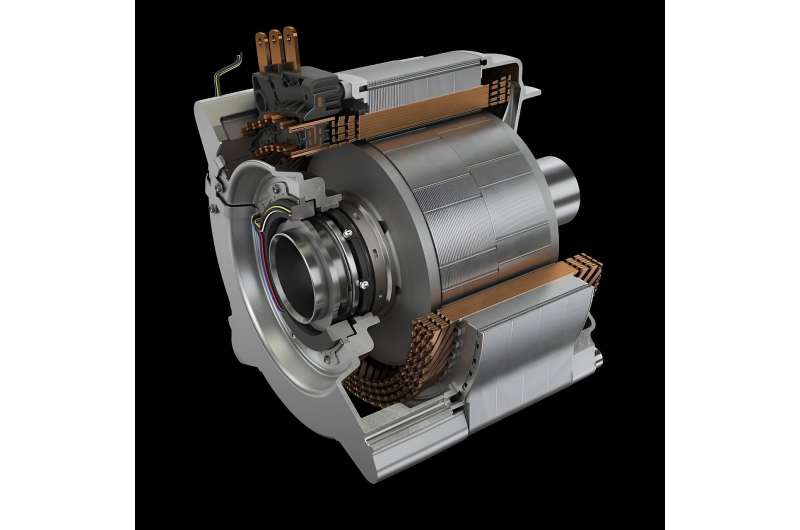This article has been reviewed according to Science X's editorial process and policies. Editors have highlighted the following attributes while ensuring the content's credibility:
fact-checked
trusted source
proofread
Electromobility: A second life for electric motors

An increasing number of electric cars are being sold, consequently raising the quantity of produced electric motors. At the end of their useful life, these electric motors are shredded and then recycled. The individual components and assemblies cannot be reused. So far, there has been a lack of sustainable value retention strategies for remanufacturing and recycling electric motors as part of a modern circular economy.
In the REASSERT project, researchers at the Fraunhofer Institute for Manufacturing Engineering and Automation IPA are working alongside industry partners to pursue various concepts for repairing, remanufacturing and reusing electric motors as well as new designs for the circular economy.
The electrification of the powertrain is continuously progressing. The electric motors used contain valuable raw materials such as copper as well as rare earth metals like neodymium, where China holds a quasi-monopoly, and which cannot be recovered with current recycling methods. Hence, extending the usage phase of the motors is increasingly important. Furthermore, the raw materials used have a bigger carbon footprint compared to a combustion engine. Because of this, it is crucial to extend the use phase of these motors.
"Innovative value retention strategies offer significant potential for emission reduction in terms of sustainability," says Julian Große Erdmann, scientist at the Fraunhofer Institute for Manufacturing Engineering and Automation IPA in Bayreuth. As part of the REASSERT project, researchers are collaborating with Schaeffler (consortium leader), the Karlsruhe Institute of Technology, BRIGHT Testing GmbH, iFAKT GmbH and Riebesam GmbH & Co. KG to develop innovative methods for remanufacturing electric motors and reusing them in vehicles.
They focus on the value retention strategies of reuse, repair, remanufacture and raw material recycling. These are key elements for a circular economy, enabling the reduction of natural resource consumption and minimization of waste.
Reducing environmental impact
At present, recycling of raw materials is the established value retention strategy. Through either manual or automated recycling methods, materials such as copper and aluminum in particular are recovered. Electric traction motors are disassembled, shredded, sorted into individual material fractions, and melted down for this purpose. However, the recycled material, which is often contaminated, can no longer be used for motor applications, and individual components and assemblies are destroyed. Therefore, raw material recycling should only be chosen as a last resort for recycling and replaced by high-quality value preservation strategies such as reuse, repair, remanufacturing, and material recycling.
"We want to establish a closed-loop system in which valuable resources are reused in order to eliminate dependency on raw material imports and to minimize raw material extraction," explains Große Erdmann. The project partners define reuse as reusing the entire engine for secondary use and repair as the replacement of defective components and assemblies. In "remanufacturing," all components are disassembled, cleaned, reconditioned, and reassembled.
"With these strategies, fewer raw materials like rare earths, copper, and others are needed, perhaps only for spare parts," the researcher elaborates. For raw material recycling, the project partners plan to disassemble the motor and sort the individual materials prior to shredding. The project partners are using reference motors from the passenger car sector to analyze and select which value retention strategies should be used in a given application.
Building a process chain from inbound inspection to end-of-line testing
The project involves establishing a complete process, each step of which boasts its own demonstrator and test rig—from inbound inspection for motor classification to disassembly, demagnetization, cleaning, component diagnosis and remanufacturing, all the way through to reassembly and end-of-line testing, where the motor's functionality is assessed.
"For instance, during this process, a motor housing with minor wear might be classified for reuse and, if necessary, reconditioned using machining processes to ensure functionality. Depending on the chosen value preservation strategy, different process steps and chains are involved, so the effort for reconditioning may vary," explains the engineer.
An example of one of the challenges of this would be disassembling and reusing the magnetic materials from motors. "A rotor with permanent magnets is difficult to disassemble into its components even in a manual disassembly process due to the coating and bonding of the magnets. Here, the goal is to establish non-destructive disassembly methods."
AI decision-making tool helps with selection of a value retention strategy
An AI tool developed as part of the project helps to select the best value retention strategy for a given application. It has access to the product and process data for the electric motor, which are saved in a digital twin.
The knowledge gathered in the project is intended to be used for the design of new electric motors. The goal is to develop a prototype motor for the circular economy that can be easily disassembled and onto which the four mentioned value preservation strategies can be effortlessly applied.


















